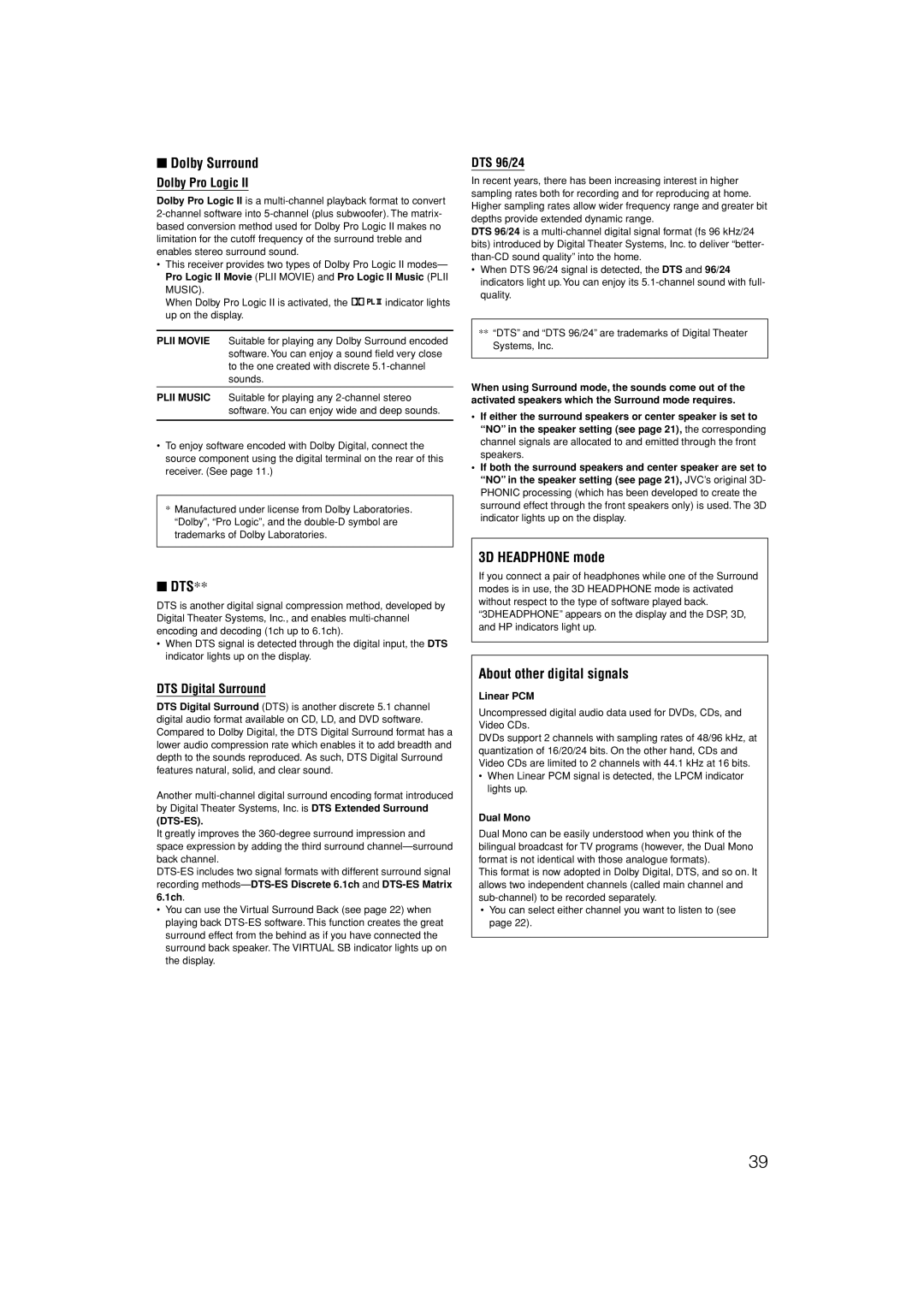
■Dolby Surround
Dolby Pro Logic II
Dolby Pro Logic II is a
•This receiver provides two types of Dolby Pro Logic II modes— Pro Logic II Movie (PLII MOVIE) and Pro Logic II Music (PLII MUSIC).
When Dolby Pro Logic II is activated, the ![]()
![]()
![]() indicator lights up on the display.
indicator lights up on the display.
PLII MOVIE Suitable for playing any Dolby Surround encoded software. You can enjoy a sound field very close to the one created with discrete
PLII MUSIC Suitable for playing any
•To enjoy software encoded with Dolby Digital, connect the source component using the digital terminal on the rear of this receiver. (See page 11.)
*Manufactured under license from Dolby Laboratories. “Dolby”, “Pro Logic”, and the
■DTS**
DTS is another digital signal compression method, developed by Digital Theater Systems, Inc., and enables
•When DTS signal is detected through the digital input, the DTS indicator lights up on the display.
DTS Digital Surround
DTS Digital Surround (DTS) is another discrete 5.1 channel digital audio format available on CD, LD, and DVD software. Compared to Dolby Digital, the DTS Digital Surround format has a lower audio compression rate which enables it to add breadth and depth to the sounds reproduced. As such, DTS Digital Surround features natural, solid, and clear sound.
Another
(DTS-ES).
It greatly improves the
•You can use the Virtual Surround Back (see page 22) when playing back
DTS 96/24
In recent years, there has been increasing interest in higher sampling rates both for recording and for reproducing at home. Higher sampling rates allow wider frequency range and greater bit depths provide extended dynamic range.
DTS 96/24 is a
•When DTS 96/24 signal is detected, the DTS and 96/24 indicators light up. You can enjoy its
**“DTS” and “DTS 96/24” are trademarks of Digital Theater Systems, Inc.
When using Surround mode, the sounds come out of the activated speakers which the Surround mode requires.
•If either the surround speakers or center speaker is set to “NO” in the speaker setting (see page 21), the corresponding channel signals are allocated to and emitted through the front speakers.
•If both the surround speakers and center speaker are set to “NO” in the speaker setting (see page 21), JVC’s original 3D- PHONIC processing (which has been developed to create the surround effect through the front speakers only) is used. The 3D indicator lights up on the display.
3D HEADPHONE mode
If you connect a pair of headphones while one of the Surround modes is in use, the 3D HEADPHONE mode is activated without respect to the type of software played back. “3DHEADPHONE” appears on the display and the DSP, 3D, and HP indicators light up.
About other digital signals
Linear PCM
Uncompressed digital audio data used for DVDs, CDs, and Video CDs.
DVDs support 2 channels with sampling rates of 48/96 kHz, at quantization of 16/20/24 bits. On the other hand, CDs and Video CDs are limited to 2 channels with 44.1 kHz at 16 bits.
•When Linear PCM signal is detected, the LPCM indicator lights up.
Dual Mono
Dual Mono can be easily understood when you think of the bilingual broadcast for TV programs (however, the Dual Mono format is not identical with those analogue formats).
This format is now adopted in Dolby Digital, DTS, and so on. It allows two independent channels (called main channel and
•You can select either channel you want to listen to (see page 22).
39
